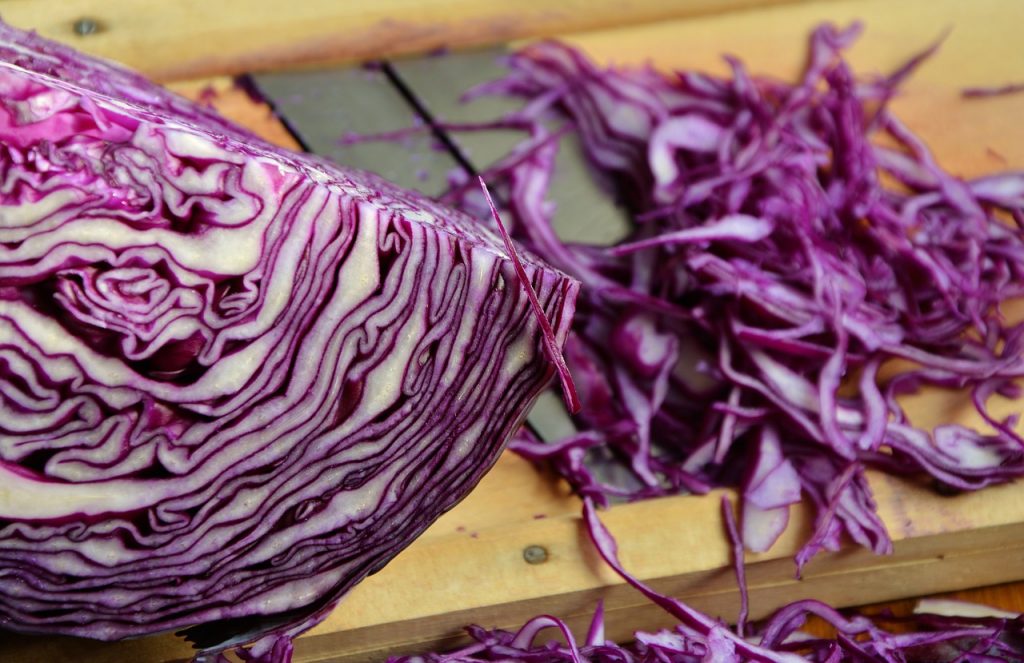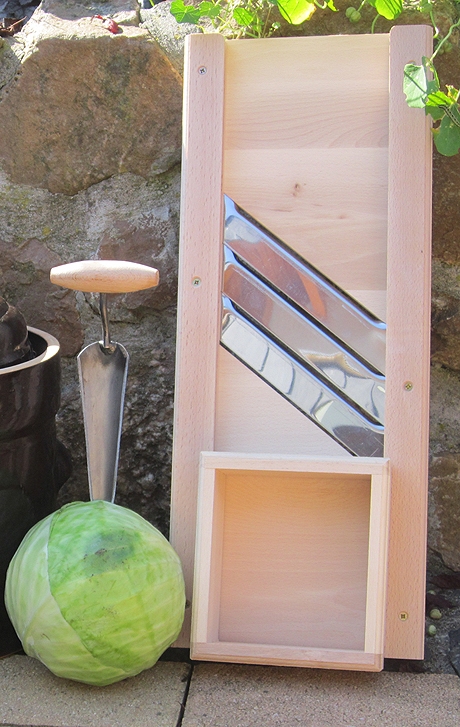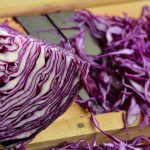We use cookies to make your experience better. To comply with the new e-Privacy directive, we need to ask for your consent to set the cookies. Learn more.
How to Make Sauerkraut

How to Make Sauerkraut
Homemade sauerkraut is easy to make and tastes delicious. Sauerkraut is made by a process called Lacto-fermentation, the lactic acid preserves the cabbabge and prevents harmful bacteria from growing.
Preparing the Cabbage

- Make sure your pot and all utensils are clean before you start. Give the cabbage head a good rinse and remove any insects or debris. Remove and discard the stump and chewy parts inside the cabbage head. Remove two large outer cabbage leaves for use later.
- Next the cabbage has to be cut up - this is best done using a cabbage slicer or mandolin. Thinly sliced pieces make it easier for the juice to be extracted form the cabbage. To cut the cabbage, place the cabbage head into the carriage of the slicer and pass over the stainless steel blades until the head is fully cut up.
- Make sure to catch any liquid released while slicing the cabbage; the liquid will later be needed for the perfect taste of the sauerkraut and to aid lactic acid fermentation.
Filling up the Fermentation Crock
- The sliced cabbage does not need any more washing before it is placed inside the fermentation crock pot. Layer your sliced cabbage in the fermentation crock pot.
- Each layer should be about 5-10 cm and should be pounded with a cabbage pounder in order to produce the liquid necessary to make sauerkraut. Between each layer of cabbage that is placed in the crock add salt* (see below) and some of your favourite spices such as bay leaves, fennel seeds, junipers, dill or caraway seeds. Add layer after layer until all the sliced cabbage is inside the crock.
- Alternatively, the cabbage/lightly salted mix can be prepared beforehand in another big pot. This way, you can leave the mix for a while after you have pounded it to allow some time for the salt to work on drawing the liquid from the cabbage cells. The more juice you can extract from the cabbage the better as it will minimise the amount of brine that may be needed in the next step.
- Make sure you leave enough room at the top of the pot for the stone weights that come with the fermentation crock.
- If not enough liquid has been released when slicing the cabbage, make a brine of 1ltr boiled water to 15g salt and top up your fermentation crock pot with the brine until cabbage is covered.
- Cover your layers of sliced cabbage in the fermentation crock pot with the saved cabbage leaves and place the stone weights on top. Make sure your stone weights are fully covered by the sauerkraut liquid. The stone weights serve to produce the pressure necessary for lactic acid fermentation.
Place the stoneware lid on top of your fermentation crock pot and fill the water trough with cooled boiled water. Don't allow the trough to go dry - check regularly! This ensures air-tight sealing of the stoneware fermentation crock. Since the fermentation crock is now sealed air-tight, no mould can form, the cabbage is protected, and the process of lactic acid fermentation can start. The fermentation crock should be placed in a cool room. Where available, a cellar is ideal for storage.
A note on salt*
- The added iodine in common table salt will interfere with the micro-organisms, so instead use sea salt. Salt helps pull liquid from the cabbage.
- You can ferment cabbage without salt but it tends to be less sour and its shelf-life will be reduced.
- The more salt you have, the slower the ferment will take. The opposite is, of course, true as well.
- Too much salt will stop fermentation altogether.
- In the first few days of the ferment, your product may taste overly salted. This will mellow as the ferment continues and more liquid is created in your fermenting vessel.
- 20g salt per kg cabbage is a good guide
How long does the fermentation process take?
Fermentation time can vary depending on the type of vegetables used. It is normally between 4 and 6 weeks. Please note that in the first 3 weeks after placing the cabbage inside the fermentation crock pot, the lid must not be taken off! Also, there should always be sufficient water in the water trough of the fermentation crock pot so that the air-tight sealing of the crock is not interrupted.
The sauerkraut is done. What next? Taking out individual portions from the fermentation crock pot on a daily basis is not recommended at all since this may expose the fermented sour vegetables to bacteria. Instead, take off a larger amount on a weekly basis and place that amount into the refrigerator inside an air-tight container. Re-open the fermentation crock pot to take out more vegetables only after you have used up the stock in the refrigerator. Alternatively, you can decant all the sauerkraut into jars. It will keep for at least two months.
What is Lacto-fermentation?
Lacto-fermentation happens when natural starches and sugars found within vegetables and fruits are converted to lactic acid by the friendly bacteria lactobacilli. The term “lacto” in lacto-fermentation, refers to the production of lactic acid. This acid is a natural preservative, inhibiting the growth of putrefying bacteria. Of all the acids common to food preservation, lactic acid is the one most easily used by the body and does not cause over-acidifying effects.
Lactic acid is a natural preservative that inhibits the growth of harmful bacteria. Beyond preservation advantages, lacto-fermentation also increases or preserves the vitamin and enzyme levels, as well as digestibility, of the fermented food. The brine used in lacto-fermented foods creates an anaerobic, acidic environment. Anaerobic means that there is no oxygen present in the environment. Many lacto-fermented recipes emphasize keeping the food below the level of the brine because the “bad guys” are unable to grow in this environment, while the “good guys” have everything they need.
Many people familiar with home food preservation are concerned about botulism. Botulism is a toxin produced by C. Botulinum bacteria and cannot survive in an acidic environment. The acids produced by fermentation protect against the toxin, and help to make lacto-fermentation one of the safest methods of food preservation.
Find our full selection of food preserving equipment here.

